In vitro effects of vasoconstrictive retraction agents on primary human gingival fibroblasts
- PMID: 32104263
- PMCID: PMC7027151
- DOI: 10.3892/etm.2020.8462
In vitro effects of vasoconstrictive retraction agents on primary human gingival fibroblasts
Abstract
The biological activity of chemical retraction/displacement agents in surrounding periodontal tissues is of unquestionable importance, but the activity of these agents has not been completely elucidated. In the present study, we aimed to evaluate the in vitro effects of vasoconstrictive retraction agents on primary human gingival fibroblasts (HGFs). A total of six commercial adrenergic solutions (0.05 and 0.01% HCl-epinephrine, two based on 0.05% HCl-tetrahydrozoline, 0.05% HCl-oxymetazoline, and 10% HCl-phenylephrine) and three experimental gel formulations (EG-1, EG-2, and EG-3) were used to treat primary HGFs. The biological effect of the retraction treatment on the expression of collagen types I and III was detected by performing immunocytochemical analysis. The generation of reactive oxygen species triggered by the retraction agents were evaluated by using the dichlorofluorescein (DCF) fluorescent probe. The effect of retraction agents on the expression of fibronectin was visualized by confocal laser scanning microscopy. According to the results, experimental retraction gels did not limit the expression of collagen types I and III. EG-3 even induced the synthesis of both types of collagen. The DCF assay indicated oxidative stress similar to the control cells for most of the selected retraction agents. Experimental gels did not cause degradation of the cellular shape and morphology of the primary HGFs. The proposed experimental retraction gels in the present study demonstrated higher biocompatibility with primary HGFs, suggesting their use as clinical vasoconstrictive agents for the application of gingival retraction with minimal damage to periodontal tissues.
Keywords: collagen types I and III; fibronectin; gingival margin retraction; human gingival fibroblasts; oxidative stress.
Copyright: © Nowakowska et al.
Figures



Similar articles
-
Biological Response Induced in Primary Human Gingival Fibroblasts upon Exposure to Various Types of Injectable Astringent Retraction Agents.Materials (Basel). 2021 Apr 20;14(8):2081. doi: 10.3390/ma14082081. Materials (Basel). 2021. PMID: 33924145 Free PMC article.
-
Cytotoxic potential of vasoconstrictor experimental gingival retraction agents: in vitro study on primary human gingival fibroblasts.Folia Biol (Praha). 2012;58(1):37-43. Folia Biol (Praha). 2012. PMID: 22464823
-
The influence of retraction agents on cytoskeleton reorganization and oxidative stress in primary human gingival fibroblasts (HGFs).Arch Oral Biol. 2014 Mar;59(3):341-8. doi: 10.1016/j.archoralbio.2013.12.011. Epub 2014 Jan 8. Arch Oral Biol. 2014. PMID: 24581858
-
Chemical Retraction Agents - in vivo and in vitro Studies into their Physico-Chemical Properties, Biocompatibility with Gingival Margin Tissues and Compatibility with Elastomer Impression Materials.Mini Rev Med Chem. 2017;17(5):435-444. doi: 10.2174/1389557516666160418122701. Mini Rev Med Chem. 2017. PMID: 27087463 Review.
-
Biological effects of interleukin-6 on Gingival Fibroblasts: Cytokine regulation in periodontitis.J Cell Physiol. 2018 Sep;233(9):6393-6400. doi: 10.1002/jcp.26521. Epub 2018 Mar 25. J Cell Physiol. 2018. PMID: 29574949 Review.
Cited by
-
Epinephrine penetrates through gingival sulcus unlike keratinized gingiva and evokes remote vasoconstriction in human.BMC Oral Health. 2020 Nov 4;20(1):305. doi: 10.1186/s12903-020-01296-z. BMC Oral Health. 2020. PMID: 33148235 Free PMC article.
-
Conceptual Model for Using Imidazoline Derivative Solutions in Pulpal Management.J Clin Med. 2021 Mar 15;10(6):1212. doi: 10.3390/jcm10061212. J Clin Med. 2021. PMID: 33803990 Free PMC article. Review.
-
Biological Response Induced in Primary Human Gingival Fibroblasts upon Exposure to Various Types of Injectable Astringent Retraction Agents.Materials (Basel). 2021 Apr 20;14(8):2081. doi: 10.3390/ma14082081. Materials (Basel). 2021. PMID: 33924145 Free PMC article.
-
Periodontitis and Systemic Disorder-An Overview of Relation and Novel Treatment Modalities.Pharmaceutics. 2021 Jul 30;13(8):1175. doi: 10.3390/pharmaceutics13081175. Pharmaceutics. 2021. PMID: 34452136 Free PMC article. Review.
-
An Oxymetazoline-Based Nasal Solution Removes Bacteria-Blood Debris on Dental Surfaces and Has Antimicrobial Activity Toward Streptococcus mutans.Int J Mol Sci. 2025 Jan 31;26(3):1242. doi: 10.3390/ijms26031242. Int J Mol Sci. 2025. PMID: 39941008 Free PMC article.
References
-
- Nowakowska D, Saczko J, Kulbacka J, Więckiewicz W. Chemical Retraction Agents–in vivo and in vitro studies into their physico-chemical properties, biocompatibility with gingival margin tissues and compatibility with elastomer impression materials. Mini Rev Med Chem. 2017;17:435–444. doi: 10.2174/1389557516666160418122701. - DOI - PubMed
-
- Nowakowska D. Classification of chemical retraction agents. Protet Stomatol. 2008;58:202–208. (In Polish)
LinkOut - more resources
Full Text Sources
